How to Can Tomatoes
Tomato season is winding down, but you still have time to jump in on the canning action. Late tomato varieties are still rolling in from the fields. Simply call different farms or produce markets in your area.
For the past two years, I have paid around 50¢ per pound for larger orders of canning tomatoes. One quart jar will hold around 2.5 pounds.
I love canning tomatoes for two simple reasons:
- They require no finesse. Using this method, you can cram the tomatoes into the jars whole, creating juice from the tomatoes themselves.
- They are so versatile. Canned tomatoes are the foundation for a hundred different winter meals. The quarts can be used as a base for chili, soup, or spaghetti sauce. The pints are great for salsa, soups, stews, or sauces. You can use a food processor or blender to get the desired consistency or simply cook the tomatoes down until they break apart.
Below is an illustrated guide to canning whole, peeled tomatoes using the cold pack method. Everybody has their own little quirks or variations, but this is a basic guide to get you started:
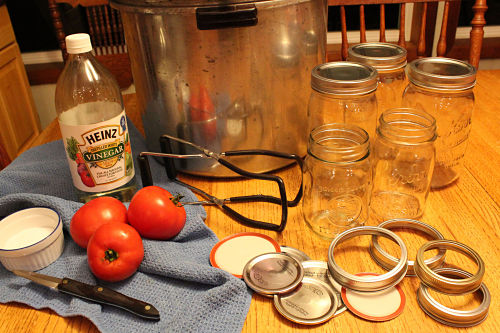
These are the ingredients and equipment you will need:
- Water bath canner & jar lifter. Canners can be picked up for under $20 and jar lifters for a couple bucks at your local Walmart, Bi-Mart, Fred Meyer, or Amazon. Both tools are great investments that can be re-used year after year. (The large pot in this picture is actually a pressure canner, but I have been using it loose-lidded for water bath canning.)
- Quart or pint-sized jars. Jars are probably the biggest investment if you are interested in getting serious about canning. However, once you have a good collection built up, you are good to go. Check with your grandma or Craigslist for used jars.
- Lids & rings/bands. Lids are only good for one use (unless you use these reusable lids), but are relatively inexpensive. Look for coupons at the beginning of the summer and discounts at the end of fall. Rings can be re-used.
- Sharp paring knife (here’s a highly-rated, inexpensive option)
- Vinegar or lemon juice, salt (optional), and of course, tomatoes
- Shallow pot for blanching
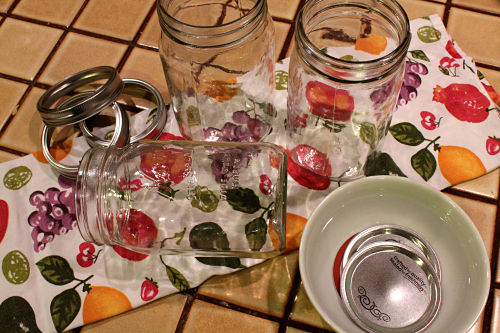
Clean, check, and sanitize your jars and lids.
Check the rims of your jars for nicks that will prevent sealing. Then run the jars through the dishwasher. If you don’t have a dishwasher, you could also submerge the jars in a canner full of water and bring to a boil for 10 minutes.
Place the lids in simmering water for 10 minutes, though the manufacturers are saying that you can skip this step now. I don’t bother sanitizing the rings as they don’t come into contact with food; simply wash as needed.
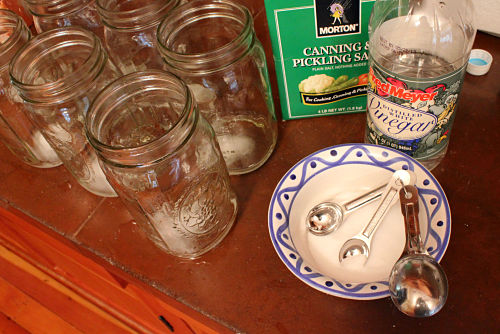
Next, prep the canner and the jars.
Fill the canner about halfway full of water, place the lid on, and turn on low. Don’t let the water get too hot; you just want to get a jump start on bringing it to a simmer.
Measure 4 T of bottled vinegar or 2 T bottled lemon juice (preferred) and 1 t. of canning salt (optional) into each quart-sized jar (halve the amounts for pints).
The lemon juice helps you achieve a safe amount of acid; the salt enhances/preserves the flavor.
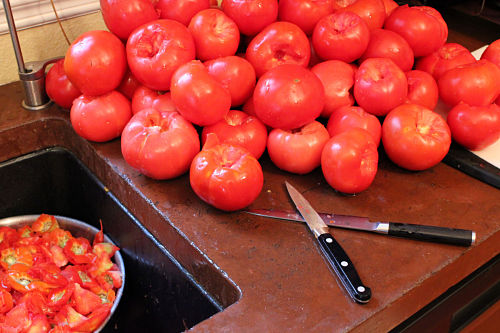
Okay, enough stalling. Now, it’s time to deal with the tomatoes. Actually, they are really easy to work with.
Using a sharp paring knife, core each tomato by removing the stem section.
If you are canning with someone else (which I highly recommend, both for speed and sanity), you can get a coring-blanching assembly line going. If you are on your own, core all of your tomatoes first. It makes the next step much easier and faster.
If you accidentally core too many tomatoes, just toss them in a pan and make Roasted Marinara Sauce.
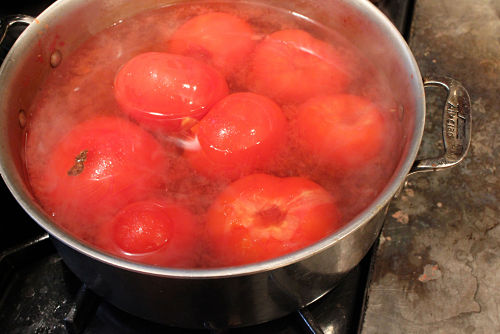
Next, place the cored tomatoes in a shallow pot of simmering water.
Blanch for 30-60 seconds and remove with a slotted spoon. You can stick the blanched tomatoes in a bowl of ice water to shock them. I usually just pile them up in a couple of big bowls to cool off.
Remove the tomato skins.
By the way, some people also advocate slicing a quick “x” on the bottom of each tomato before blanching. As long as you are working with ripe tomatoes, you really don’t need this step. The skins will slip off easily. If your tomatoes are a tad on the green side, go for the x. It will make peeling easier.
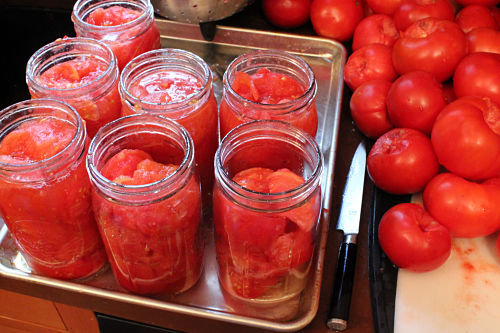
Now for the fun part; fill the jars with the peeled tomatoes.
If your tomatoes are small, you can leave them whole. If your tomatoes are large, cut them in halves or fourths, whatever size is manageable. You don’t need to be timid with them.
As you fill the jars, gently press the tomatoes down, creating juice in the process.
When the jar is full and finished, the tomatoes should come to the bottom of the jar threads, leaving about 1/2 inch of headspace at the top of the jar.
Run a plastic utensil between the jar and the tomatoes, pressing into the tomatoes to release any trapped air bubbles.
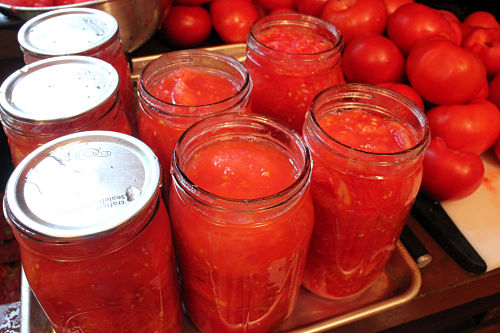
Using a clean towel, wipe the rims of each jar. Place a lid on top and screw on the rings finger-tight.
IMPORTANT: Check the water in the canner. It should be warm but not scalding hot. Placing cool jars into a hot canner is a bad combination.
Gently lower the jars into the warm water using your fingers or jar lifter. Once all of your jars are in, make sure the tops are covered with 1-2 inches of water. Place the lid back on the canner.
Bring to a gentle rolling boil. Maintain a constant boil and process both pints & quarts for 85 minutes.
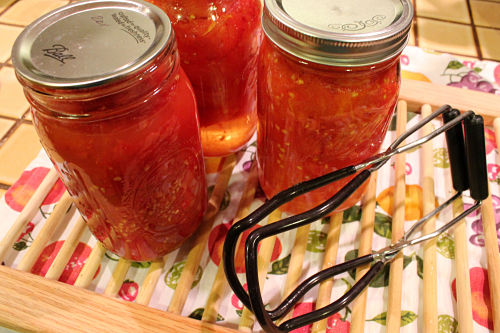
When the timer rings, remove the hot jars with the jar lifter and place on a towel or rack to cool.
As the jars cool, the lids will suck in and seal. You can check the seals by running your fingertips lightly over the lids. Any jars that do not seal can be dumped in a new jar with a new lid to process again or placed in the refrigerator for use in the near future.
Don’t worry if your tomatoes rise to the top and separate slightly from the juice. It may look funny, but they will taste just fine.
After 8-12 hours, remove the rings, rinse off the jars, and store them in a cool, dry place.
We have several canning posts here on the blog. Check them out!
- Canning for Beginners FAQ’s
- Canning Applesauce
- Canning Peach Vanilla Bean Jam
- Canning Peaches
- Canning Sweet Cherries
- Canning Tomatoes
- Water Bath Canning Guide
- Water Bath Canning Equipment
Looking for more tomato-related deliciousness?
For more information on canning tomatoes, check out these great resources:
- Pick Your Own – How to Can Fresh Tomatoes
- Food in Jars – Canning Whole Peeled Tomatoes
- NCHFP – Selecting, Preparing, and Canning Tomatoes
Are you new to canning? Be sure to go through our Home Canning Guide posts for a beginners guide, equipment suggestions, and recipes!
Follow Frugal Living NW on Pinterest!
Fantastic range of boards from best recipes and tips for frugal living to gardening and budgeting help.
This post may contain affiliate links. See the disclosure policy for more information.
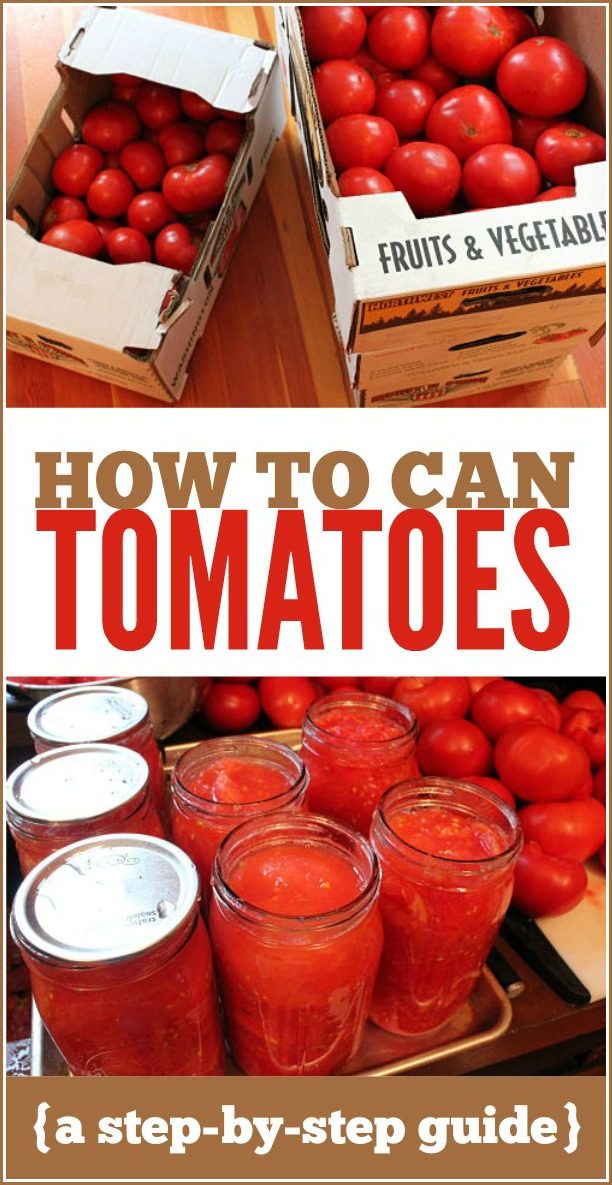
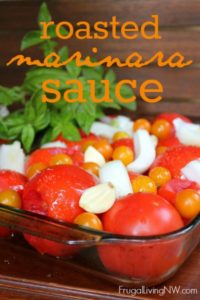

yes, the tomato skins are removed due to texture. if i am pureed tomato sauce in the blender, i leave them in. otherwise, they are annoying tough bits in diced or whole tomatoes. something to do with the skins is dry, pulverize and sprinkle on top of food for color. i plan to experiment this season with adding powdered tomato skins to my recipe for noodles. perhaps a bit of nutrition and some color.
Thank you for the super informative tutorial! Is it necessary to remove the tomato skins? Is it just because of the texture? If I do not removed the skins… do I still need to blanche the tomatoes? I am planning on canning diced tomatoes – to be used for sauces, chilis, soups, etc.
Also, is it possible to sub out the bottled lemon juice for citric acid? If so, would you happen to know the measurement?
Thanks!
just an extra idea for you if you have freezer space. you can rinse and core your tomatoes, place them in freezer bags, and pop into the freezer. take them out some cold winter day when you would actually welcome the heat and humidity of canning. when thawed, you will find that the skins will slip right off. makes canning faster, easier, and happening when it may be better for you. 🙂
Would it be safe to add some fresh garlic to this as well?
Nope… add other ingredients at the time of your meal prep. Tomatoes are about the only FOOD that can be canned without a pressure canner. It’s a BOTULISM thing Rebecca and others.. Chk with the usda, county extensions and a few other well experienced frugal home steaders. Re, Lisa Bedford (survival mom), Sharon Peterson (simply canning) etc etc be well and be safe dannydan 😉
Thank you so much for this post. I’m comfortable with boiling water method and uncomfortable with pressure cooking.
Like Susan said, this year has been unbelievable for tomatoes in the PNW! Not only for quantity, but quality. Thank you for this post and the comments. I’ve filled up my freezer but I will look over your posts and comments and attempt canning the last of the season.
If you are using a pressure cooker process quarts at 10 pounds of pressure for 10 minutes.
I know this is an old post, but I have a question. I have been canning for a few years now ((all different kinds of stuff)) and I canned my own tomato sauce two years ago. I canned it in pint jars and put 1 Tbsp of lemon juice in with each jar for the same reasons as you listed. However, all of the tomato sauce tastes like lemon and I hate that. I can’t even eat it. I have tried to put a little sugar in it when I open a jar to cook it ((to kind of cancel out the lemony-acidic taste)) and that doesn’t work either. Have you ever made sauce and canned it and experienced the same thing? If so, how did you remedy it? I appreciate any help I can get as I am about to can another batch this summer. I actually want to be able to enjoy it this time! :]
Have you found anything out on this? I’ve always just frozen my tomatoes in ziplock bags (with nothing added). Would love to know if you could can them without any additives too. (The jars are just sooo much prettier)
I think you are using WAY too much lemon juice. I would try a half a teaspoon in a pint and you’ll have enough acidity to be safe. I think tomatoes are acidic enough to can just the way they are, but the extra acidity from the lemon (or lime or vinegar) would be an added security feature.
I just thought I would add that there is a great resource for canners with questions. Oregon State University has a Food Safety/Preservation Hotline. It’s staffed by trained Master Food Preservers. The toll free # is 1-800-354-7319. (mon-thurs 9am-4pm).
I also thought some of you would like to know where the time varies from 35 mins. to 85 mins. The time you use in canning your tomatoes depends on wether you are using pints or quarts AND how you are packing the tomatoes: crushed, whole/halved in water, whole halved in juice, whole/halved without any liquid added. It also depends a great deal on what altitude you live at. 35 minutes water bath is completely safe for crushed tomatoes in PINT jars, packed HOT w/o any added liquid and not above 1000′ elevation. (that’s a lot to consider!) The 85 minutes is also for that elevation but if you are canning whole/halved tomatoes in juice or raw packed and at that elevation.
This information is from a pamphlet I recieved from the extension office PNW 300, Canning Tomatoes and Tomato products. Call the hotline too, they are happy to help you! Canning methods have changed because our varieties in our tomatoes and other food have changed.
Emily, thank you for updating your sources and giving current information. It means a great deal to me that you took the time to update the information and provide accurate links that only work but are useful as well. I will spread the word that Frugal Living is willing to take that extra step to show its readership they care.
Thanks for all you do here! 🙂
I’m curious: I just started canning this summer myself, and have been doing all the research I can. This is the first time I’ve read the 85 min guideline myself, but I have a pressure canner and can just do it that way if it will cut back on time.
So what I was curious about was how these guidelines were set. It was 35 min for many years- so what prompted the change? How are these guidelines set in the first place, and then what has to happen to get them changed, especially a change this relatively extreme? If that makes sense 🙂
I’m just curious about the whole thing. Especially since botulism is super scary and gnarly. A youngish guy around here got it about 5 or 6 years ago from eating improperly canned venison stew, and it took about a year for him to be able to even walk again. They detailed his journey in the paper over that time, and it scared me straight into canning paranoia.
Yes (speaking as a nurse) botulism is scary & my mom poo-poos it, as she did it many years herself and we never got sick.
What I have read though is that our current varieties of tomatoes are less acidic-so that is why it is more of an issue now.
Hopefully Linda above will read this & know if this is correct-I had another question for her too, that boiling the tomatoes first made it safe to then can in a water bath.
That is a good question, Jodi. The changing recommendations reminds me of the ever-changing guidelines for parents! 🙂
Pick Your Own has a helpful Q&A regarding botulism. http://pickyourown.org/botulism.htm
I was surprised to read how relatively few cases of botulism are reported in the US each year: around 145, of which only 15% are food-borne.
It is definitely something to be aware of and take seriously, but as long as you follow set recipes, procedures, and processing times you should be just fine.
I think the additional advice to boil your canned tomatoes for 10 minutes is good, especially if you are nervous about it.
Haha- it’s totally like parenting guidelines 🙂 Or pregnancy dos and don’ts. Hopefully she’ll see this.
I think I did a no-no the other day though: I canned peaches, and was also making salsa at the same time to can. Instead of using concentrated lemon juice, I used some that I had squeezed fresh for the salsa. The instructions I was using didn’t clarify why one versus the other was important. Sooo, now I have seven jars I’m a little paranoid abut. I was thinking of just trying to use them up quickly, like by making a cobbler or a few pies or something.
And I love the pickyouown site! Although that was the one I was using when canning.
I don’t think peaches are an issue-it is tomatoes and vegetables.
You are welcome, Charolyn.
Peaches are a high acid fruit and they do not need any acid added unless it is a fruit salsa or something with ingredients other than the fruit.
It is the salsa that is the concern. I am afraid it is probably unsafe. Only bottled lemon juice is safe to use in salsa unless it also has a lot of vinegar. I am concerned you did not follow a safety tested recipe. If you made up your own, I am assuming it will not be safe to eat… if you will send your recipe I can verify it one way or another. One of the number one guidelines is NEVER make up your own recipes or use one from someone that has no food preservation safety training. Well meaning people write and post all kinds of recipes, but that will not insure they are safe to follow. If you want to use your own recipe, we suggest you freeze it instead.
I am truly wanting to be sure you and your loved ones are safe ! Please, don’t take any of this as me being critical. I hope to insure your safety, as well as loss of your time, energy, and money involved in canning.
Truly,
Linda
Well, I simmered the salsa for a few hours first before canning, so it wasn’t canned raw. And the recipe I used was a variation on one I got from pickyourown.com. I don’t remember if the author specified bottled vs. fresh lemon juice.
You must have bottled lemon juice, and not fresh, as fresh are not acidic enough. Please, check the Univ. of Georgia website or a current Ball Blue Book. Some universities are now saying 90 min. not just 85. It is better, in my opinion, to use current methods and use a pressure canner for totmatoes.
There is a potential of botulism with improperly acidified tomatoes.
The same thing will hold true for the person using less processing time than called for. The 85 min. guideline has been in effect for many years now.
A few years ago (but maybe 10 now!) I read that you can still can in a water bath if you boil the tomatoes first for a certain period of time. Is that still considered safe & how long do you boil for?
Personally I freeze, as canning is too much work for me.
I edited the post to 4 T. vinegar. Thanks for the input.
Thank you, Emily, for correcting the amount of vinegar to add. We don’t suggest the vinegar mostly due to the flavor it gives them.
I was glad to see you said to store the jars with no rings on them. The only purpose of the ring is to hold it on during processing.
You can heat the tomatoes first, but it depends upon the size of the pieces of tomatoes as to how long they are processed. Also, some foods will vary on the processing times if it is a hot pack or a raw packed food.
What we at the extension office like to recommend is the hot packed, crushed tomatoes.
You don’t get nearly as much floating of the tomatoes when you follow that method.
In order to do that, you put in a layer of cut up, or quartered, peeled tomatoes in the bottom of your pan. Then, heat as quickly as you can, mashing them with a wooden spoon. Then, you just need to add the rest in batches to that pot, heating them as you go. Bring them all to a boil and cook for 5 min. before they go into your jars.
Studies show that the tomatoes are more nutritious done in the pressure canner and also you get a better quality product.
You can still process the crushed tomatoes in a boiling water bath canner, too. The time for that is 35 min. for pints, and 45 for quarts at sea level. You still acidify them.
Tomatoes are often less acidic now that they used to be. Some of it is because of our soils, our water, and other factors.
Botulism is not real common, but it does happen.
As for food storage time, most all foods have only a safe shelf life in the fridge for 2 to 3 days. If you see signs of spoilage, the food was bad long before you notice any signs.
If you have any questions, please feel free to ask me. I am happy to help.
I hope I have answered all the questions here. Oh, and that is correct about not using a metal utensil in the jars. A plastic kife or even a chop stick will work. You can also buy a plastic ” bubble freer”.
Truly,
Linda
Thanks Linda for your time & concern & knowledge!
Great post! Can’t wait to try this!
You make it seem easy. I’ve never canned, though I’ve bought jars, etc. Now I just have to do it
Oh, and I have to add this tip I read on my SIL’s blog (www.lovingmydomesticlife.com) :
After canning with her landlady she was surprised to hear her recommendation to let the jars sit for AT LEAST A WEEK after they are canned. When she asked why so long, her landlady said with a straightface, “So your husband knows how hard you worked! ” HAHA! So hilarious! 🙂
I love it! I leave my jars out on the counter for several days, too. Just to admire.
So a friend and I did this last Thursday and I ran out of bands and time at her house (spent most of it chasing around my baby), so I brought home a big pot of peeled tomatoes which I planned to finish canning or use to make salsa and then freeze since I don’t have a canner and didn’t want to try to juggle it timewise with my baby. Anyway, I kinda forgot about them in my garage fridge and they were in there 6 days before I finally them in gallon size ziplocks and threw them in the freezer. SO, my question is: DO YOU GIRLS THINK THEY ARE STILL GOOD? They smelled like tomatoes and looked fine…no mold or anything. I would hate to throw them away if I don’t need to, but I don’t want to use them and make people sick if they are rotten! Please help! 🙂
It seems like they would have looked/smelled off. Tomatoes get a zingy flavor when they are going south so you should be able to taste it, but I’d say go with your gut feeling on this one (no pun intended). I’m with you – I’d hate to make someone sick, but oh, all that work! 🙂
I too agonize over these issues-I made the roasted tomato sauce last Friday & just pureed and froze it yesterday-so 5 days. I brought it to a boil and boiled it for 10 minutes to be on the safe side-they looked fine to me too. I have been eating things that were in the fridge about 6 days recently, and haven’t had any problems.
Just curious, why do you remove the rings before storing?
I remove them for two reasons: 1) to use on other jars and 2) sometimes liquid bubbles out, making the ring sticky and harder to remove later. Some people have also complained of rust around their rings/jar necks after awhile because of this.
Where did you find new recommendations for boiling times? 85 minutes is a long time!
Processing times used to be 35 minutes for pints and 45 for quarts, but newer guidelines have bumped it up to 85 minutes.
Thanks for all your canning posts this summer. It’s nice to hear from others who enjoy canning all the fabulous fruits and veggies we have here in the NW.